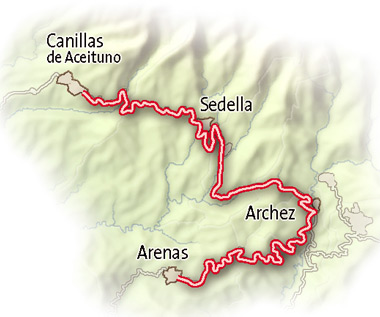
This route leads the traveller through five settlements in the interior of Axarquia, in an area which is orographically mountainous; enclaves with a genuine rural flavour where there still survive magnificent examples of Mudéjar architecture.
Axarquia as a mountainous region, conserved, after the reconquest, an important population, as much Mudejar, maintaining its religion and customs, as Morisco, or vice versa. The Castillians re-used and Christianised some of the existing constructions and made use of the previous urban layout. The traveller may start the route in a small hollow surrounded by hills in which is enclosed Arenas, where one may visit the castle of Bentomiz erected by the Arabs on an Iberian base. In the immediate area is found the Alminar de Daimalos, in the locality of the same name. With hardly four hundred inhabitants, Archez still preserves its Moorish roots and enchantment. One is talking about a charming little hamlet of Axarquia with a labrynthine layout of narrow streets. Before being expelled the Muslims of the place left for posterity a valuable treasure of Nazarine architecture: the Minaret Tower of the church of Nuestra Señora de la Encarnacion, constructed in the fourteenth century and now topped by a Christian bell tower. Another beautiful example of this Mudejar art is situated in Salares, where the parochial church of Santa Ana preserves the Minaret Tower constructed between the thirteenth and fourteenth century. In the fiestas of this latter village the traveller will have the oportunity to taste a wine quite unlike any other, due to the use of an unusual grape called the Rome. Hardly four kilometres away appears Sedella:steep streets,blindingly white facades and a medieval tower with Moorish decoration.
| 
